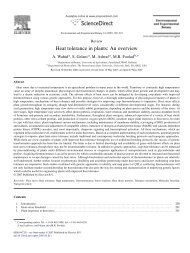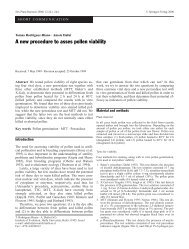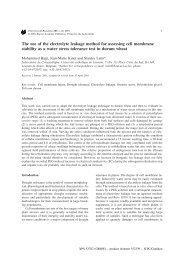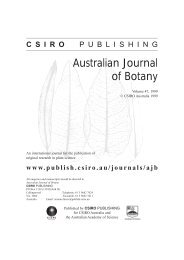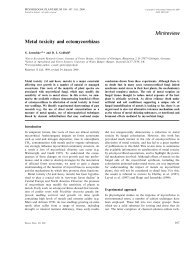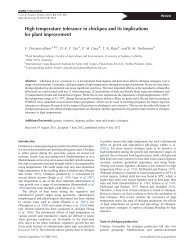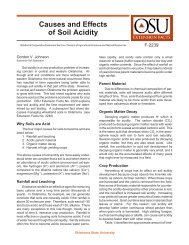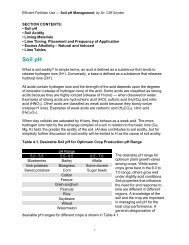Australian Trees for the Rehabilitation of Waterlogged and Salinity ...
Australian Trees for the Rehabilitation of Waterlogged and Salinity ...
Australian Trees for the Rehabilitation of Waterlogged and Salinity ...
You also want an ePaper? Increase the reach of your titles
YUMPU automatically turns print PDFs into web optimized ePapers that Google loves.
702 D. T. Bell<br />
conditions. Casuarina equisetifolia was among <strong>the</strong> most tolerant <strong>of</strong> species trialled in India<br />
(Hussain et al. 1994; Singh et al. 1994). Deaths <strong>of</strong> Melaleuca strobophylla <strong>and</strong> Casuarina<br />
obesa at Lake Toolibin in Western Australia, a lake in <strong>the</strong> wheatbelt that is affected by<br />
increased inundation <strong>and</strong> secondary salinisation, appear to be caused by salinity concentration<br />
ra<strong>the</strong>r than increased frequency <strong>and</strong> duration <strong>of</strong> flooding (Froend et al. 1987; Bell <strong>and</strong> Froend<br />
1990). Deaths <strong>of</strong> Melaleuca ericifolia in <strong>the</strong> Gippsl<strong>and</strong> Lakes region have also been attributed<br />
to increasing salinity (Ladiges et al. 1981). Melaleuca <strong>and</strong> Casuarina are <strong>the</strong>re<strong>for</strong>e capable <strong>of</strong><br />
surviving extended periods <strong>of</strong> waterlogging, but suffer from <strong>the</strong> effects <strong>of</strong> increased salinity.<br />
Anatomy, Morphology <strong>and</strong> Physiology <strong>of</strong> Tolerant Species<br />
Tolerance at Seed Germination<br />
Underst<strong>and</strong>ing <strong>the</strong> anatomy, morphology <strong>and</strong> physiology <strong>of</strong> tolerant genotypes can improve<br />
<strong>the</strong> practice <strong>of</strong> placing ‘<strong>the</strong> right tree in <strong>the</strong> right place’. The timing <strong>of</strong> planting <strong>and</strong> <strong>the</strong><br />
underst<strong>and</strong>ing <strong>of</strong> tolerance at different stages <strong>of</strong> <strong>the</strong> life cycle are also important in <strong>the</strong> design<br />
<strong>of</strong> revegetation. Direct seeding into zones <strong>of</strong> winter soil saturation <strong>and</strong> salinity presents major<br />
environmental stress <strong>for</strong> germination. Seeds <strong>of</strong> Melaleuca ericifolia can germinate while<br />
submerged <strong>and</strong> are <strong>the</strong>re<strong>for</strong>e metabolically adapted to anaerobic conditions (Ladiges et al.<br />
1981). Germination is also strongly influenced by <strong>the</strong> osmotic pressure <strong>of</strong> salts in <strong>the</strong> soil<br />
solution. Seeds <strong>of</strong> Eucalyptus occidentalis, E. eremophila <strong>and</strong> Melaleuca cardiophylla<br />
withst<strong>and</strong> <strong>the</strong> osmotic pressure effects <strong>of</strong> salts in <strong>the</strong> soil or toxic ion effects after imbibition<br />
<strong>and</strong> germinate in 200 mM NaCl, but in most species germination is severely limited at <strong>the</strong>se<br />
concentrations (van der Moezel <strong>and</strong> Bell 1987a). Although some species have developed<br />
tolerance at <strong>the</strong> germination phase <strong>of</strong> <strong>the</strong> life cycle, most germinate at less stressful periods <strong>of</strong><br />
<strong>the</strong> year. Dormancy is generally maintained until rainfall dilutes external osmotic potentials<br />
to levels which allow imbibition (Bell et al. 1993a). Fur<strong>the</strong>rmore <strong>the</strong>re is no relationship<br />
between waterlogging <strong>and</strong> salt tolerance during germination <strong>and</strong> subsequent tolerances as<br />
seedlings (Ayers 1952; Rozema 1975; Ladiges et al. 1981; Clemens et al. 1983; Pearce-Pinto<br />
et al. 1990) or adult plants (Morris 1984). In summary, planting <strong>of</strong> established seedlings <strong>of</strong><br />
species with known tolerance in discharge zones <strong>of</strong> damaged agricultural catchments is<br />
preferred to direct seeding <strong>of</strong> waterlogged <strong>and</strong> saline sites.<br />
Mechanisms <strong>of</strong> Waterlogging Tolerance<br />
The physiological consequences <strong>of</strong> waterlogging <strong>of</strong> <strong>the</strong> soil are changes in stomatal<br />
aperture, transpiration, permeability <strong>of</strong> root membrane, levels <strong>of</strong> abscisic acid, cytokinins <strong>and</strong><br />
gibberellins, <strong>and</strong> <strong>the</strong> absorption <strong>of</strong> water (Drew <strong>and</strong> Lynch 1980; Brad<strong>for</strong>d <strong>and</strong> Yang 1981;<br />
Kozlowski 1984). Resistance is likely to relate to a complex mix <strong>of</strong> relevant traits interrelating<br />
to enhance survival <strong>and</strong> growth (Flowers <strong>and</strong> Yeo 1995). There<strong>for</strong>e, genotype<br />
selection requires knowledge <strong>of</strong> a range <strong>of</strong> attributes <strong>and</strong> <strong>the</strong>ir importance in <strong>the</strong> ecological<br />
approach to redressing l<strong>and</strong> loss due to waterlogging <strong>and</strong> salinity. Adventitious roots, stem<br />
hypertrophy <strong>and</strong> <strong>the</strong> production <strong>of</strong> aerenchyma tissue are induced by flooding in seedlings <strong>of</strong><br />
Eucalyptus viminalis, E. ovata <strong>and</strong> E. robusta (Clemens <strong>and</strong> Pearson 1977; Ladiges <strong>and</strong><br />
Kelso 1977). The greater flooding tolerance <strong>of</strong> E. camaldulensis compared with E. globulus<br />
has been attributed to an ability <strong>of</strong> <strong>the</strong> <strong>for</strong>mer to produce adventitious roots on submerged<br />
portions <strong>of</strong> <strong>the</strong> stem (Sena Gomes <strong>and</strong> Kozlowski 1980a; Blake <strong>and</strong> Reid 1981; Marcar<br />
1993). The capacity to produce adventitious roots was also associated with <strong>the</strong> comparative<br />
flooding tolerances <strong>of</strong> E. gr<strong>and</strong>is, E. robusta <strong>and</strong> E. saligna (Clemens et al. 1978). Flooded<br />
plants show transient water deficits, reduced stomatal conductance <strong>and</strong> transpiration, <strong>and</strong><br />
limited growth rates when roots suffer oxygen deficits immediately after waterlogging (Sena<br />
Gomes <strong>and</strong> Kozlowski 1980a, 1980b). However, <strong>the</strong> development <strong>of</strong> adventitious roots<br />
above <strong>the</strong> level <strong>of</strong> flooding restores gas exchange capacity, <strong>and</strong> returns water relations <strong>and</strong><br />
growth rates to those existing prior to waterlogging (Sena Gomes <strong>and</strong> Kozlowski 1980a,



